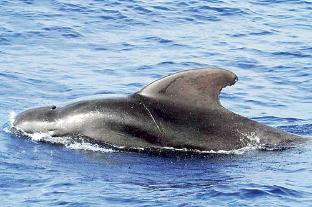Published in the Ocean Watch column, Honolulu Star-Advertiser © Susan Scott
April 4, 2011
I don’t know whether they have hot flashes, but female pilot whales go through menopause.
That fact was discovered in 1984 after researchers examined 298 bodies of short-finned pilot whales killed for food in Japan. By using growth layers in teeth to determine each whale’s age, the scientists learned that female pilot whales stop reproducing at 36 years of age, and their ovaries wither, yet they live nearly 30 more years, to about 65. Male pilot whales don’t live much past 40.
 Courtesy of Robin W. Baird
Courtesy of Robin W. Baird
A pilot whale swims off Hawaii island in 2010.
This is notable because most mammals die soon after their gonads give out. So far, only pilot whale, orca and human females are known to live beyond their powers of procreation.
One explanation for life after menopause is the grandmother hypothesis, a theory that older females help younger relatives raise their offspring. Like people and killer whales, pilot whales also live in genetically related family groups.
And here’s some spicy food for thought (boomers take heart): Female pilot whales continue to copulate long after their ovaries quit. This, researchers speculate, might help stabilize the pod by reducing fighting among lusty males and/or keeping them from wandering to other pods looking for love.
Pilot whales got my attention after several pods passed my sailboat in the Sea of Cortez (Gulf of California). The little 20-foot-long charmers were short-finned pilot whales, a warm-water member of the dolphin family. These animals’ front flippers are about one-sixth their body length.
The only other pilot whale in the world is a long-finned species with fins about one-fourth its body length. These whales also live in kin-based groups but prefer the cold waters of the North Atlantic and Southern Ocean. There are no grandma baby sitters in these pods. In one of evolution’s mysteries, long-finned females do not live long after their ovaries stop producing eggs.
Pilot whales are easy to identify from a boat because they have a look and behavior all their own. The name of their genus, Globicephala, means “globe head” and refers to the whales’ well-defined, bulbous foreheads. In some areas these whales are called potheads.
Pilot whales got their name from the probably false belief that a single member leads the pod, even to death on a beach. Another source says that the term “pilot” came from the notion that these whales guide fishermen to a catch. This might be partially true because pilot whales sometimes associate with schools of herring, tuna and the whales’ favorite food, squid.
I’ve read that pilot whales often swim abreast of one another, and I finally saw them do it. The whales I spotted were swimming shoulder to shoulder at speed, their distinct round heads and broad dorsal fins rising up and down on the surface like black pistons. This chorus-line behavior might increase the group’s chance of finding a school of squid.
Here in Hawaii we have our own resident population of short-finned pilot whales. You can read about ongoing research on our whales, and see outstanding photos of them, at Cascadia Research. It’s not possible to pick out the feisty grandmothers from other pod members in the pictures, but I like knowing they’re there. In the world of mammals, we aging females are not alone.